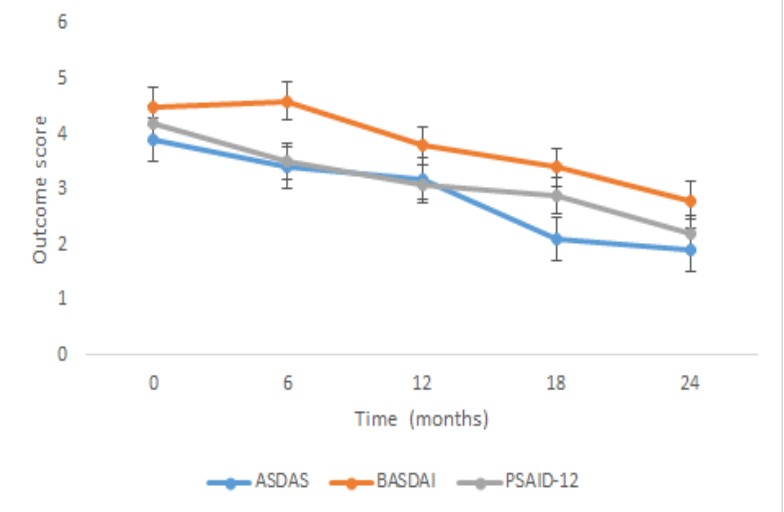Session Information
Session Type: Poster Session D
Session Time: 8:30AM-10:30AM
Background/Purpose: Patient-reported outcomes (PROs) have always been at the forefront for the assessment of spondyloarthritis (SpA) which includes axial Spa (axSpA) and psoriatic arthritis (PsA). With the increasing adoption of electronic health records (EHRs), collecting PROs electronically (ePRO) presents a great opportunity for advancing patient care in SpA. Electronic PROs are useful for guiding treatment decisions, with the aim of improving health outcomes through patient empowerment.
Methods: Electronic PROs were incorporated the in to routine clinical practice and the EHR at Royal Berkshire Hospital in Reading, UK since 2018. AxSpA patients meeting the ASAS criteria routinely completed the outcome measures BASDAI, BASFI, Spinal NPRS, and BASG. PsA patients meeting the CASPAR criteria completed patient assessed tender joint, swollen joint, global assessment, PSAID-12. Patients were sent reminders to complete the questionnaires through email or text messaging before each appointment and every 6 months routinely. The development of a clinician dashboard captures a range of multidimensional ePROs that was used proactively to support patient-centric appointment scheduling. Appointments were expedited or deferred depending on the clinical outcome scores. This enabled the clinical team to arrange non face to face / virtual follow-up appointments with some patients.
Results: There are 998 patients with AxSpA and PsA of which approximately 70% (n=692) completed the ePRO questionnaires. Over a 2.5 year period (2018-2021), a total of n=692 patients (n=470 axSpA and n=222 PsA patients) were recruited into the ePRO system. The mean (SD) age for axSpA patients were 44.7(13.3) and PsA 54 (9.9) years. n=308 (44%) patients were on biologics. At group level, there was a trend to the reduction in mean (SD) ASDAS at months 0, 6, 12, 18 and 24 (3.9±1.2, 3.4±1.1, 3.2±1.5, 2.1±0.9, 1.9±1.0) and BASDAI (4.5±2.7, 4.6±1.9, 3.8±2.4, 3.4±2.3, 2.8±1.2). In the PsA group, there was also a trend to the reduction in the mean (SD) PSAID-12 level (4.2±1.8, 3.5±0.8, 3.1±1.2, 2.9±1.1, 2.2±1.3). The reduction in ASDAS, BASDAI and PSAID-12 was most evident in patients on biologic treatments. In patients with an ASDAS of < 1.3 and PSAID-12 < 2, appointments were moved from routine 6 monthly to 12 monthly. In this group of patients, the appointments were also switched from face to face to video consultation. This resulted in a saving of 250 hours of clinical time. Over 90% of clinician and patient user rated the ePRO application as good or very good.
Conclusion: For this cohort of SpA patients, a trend based on questionnaire scores collated over a period was more informative, particularly when considered alongside interventions that were introduced into the clinics such as physiotherapy, psychological therapy and biologic treatment. In addition, by facilitating timely and effective use of ePROs, clinic workload has reduced allowing time for ‘flare’ slots and virtual clinics as well as the opportunity to stratify patients according to their disease activity e.g. mild/ moderate/severe. The system allows clinical encounters where needed, and more individualised treatment by identifying the patient perceptions of disease impact.
 Outcome measure (ASDAS, BASDAI and PSAID_12) scores at baseline and 6 month interval for 24 months.
Outcome measure (ASDAS, BASDAI and PSAID_12) scores at baseline and 6 month interval for 24 months.
To cite this abstract in AMA style:
Chan A, Rigler K, van Rossen L. Improving Care and Capacity Through Capturing and Recording Patient Reported Outcomes with Digital Solutions in Spondyloarthritis [abstract]. Arthritis Rheumatol. 2021; 73 (suppl 9). https://acrabstracts.org/abstract/improving-care-and-capacity-through-capturing-and-recording-patient-reported-outcomes-with-digital-solutions-in-spondyloarthritis/. Accessed .« Back to ACR Convergence 2021
ACR Meeting Abstracts - https://acrabstracts.org/abstract/improving-care-and-capacity-through-capturing-and-recording-patient-reported-outcomes-with-digital-solutions-in-spondyloarthritis/
